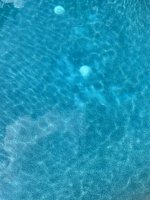- Jul 18, 2018
- 189
- Pool Size
- 23000
- Surface
- Vinyl
- Chlorine
- Salt Water Generator
- SWG Type
- Hayward Aqua Rite (T-15)
Well I shouldn’t have done it but I went ahead and tested my phosphates today with the Taylor kit and based on the color comparator it looks like they are in the 3000ppb range. I am aware of the debate regarding removing phosphates and haven’t decided yet whether or not to do it. If I decide to do it it won’t be until the end of the season because of the cloudiness and having to clean the cartridge filter etc. My water is TFP clear and I always keep my FC at the high end based on my CYA.
I bought the test kit a few years back and when I first tested for phosphates it was in the 500ppb range. So my pool is getting phosphates from somewhere and assuming I do not remove them I can also assume they will continue to increase. I know nothing about chemistry but my common sense tells me that once the phosphates reach a certain amount that it doesn’t matter if it is 3000ppb or 30,000ppb because the algae can only consume so much. Is this true? The reason I ask is that if I decide to remove the phosphates it only makes sense to try to get the amount to zero. If I cannot do that why go through the hassle?
I don’t want to reignite the debate on removal, I need to decide that. But I guess I am really asking if the amount is not zero or some ridiculously low amount does it even matter how much is in the pool?
I bought the test kit a few years back and when I first tested for phosphates it was in the 500ppb range. So my pool is getting phosphates from somewhere and assuming I do not remove them I can also assume they will continue to increase. I know nothing about chemistry but my common sense tells me that once the phosphates reach a certain amount that it doesn’t matter if it is 3000ppb or 30,000ppb because the algae can only consume so much. Is this true? The reason I ask is that if I decide to remove the phosphates it only makes sense to try to get the amount to zero. If I cannot do that why go through the hassle?
I don’t want to reignite the debate on removal, I need to decide that. But I guess I am really asking if the amount is not zero or some ridiculously low amount does it even matter how much is in the pool?


